Contents
Cotoneaster is an evergreen or deciduous shrub used in landscape design. Some species of this plant have edible fruits, but most of them are planted only for decorative purposes. Due to its undemanding to growing conditions, longevity, ease of cultivation and attractive appearance, the shrub is widely used for decorating gardens, park areas, as well as for strengthening bulk soil.
General description of cotoneaster
Translated from Latin, the name of this shrub means “resembling quince.” Indeed, the leaves of some of its species have a certain resemblance to the fruits of this tree. The shrub is widespread not only in Eurasia, it is also found in North Africa.
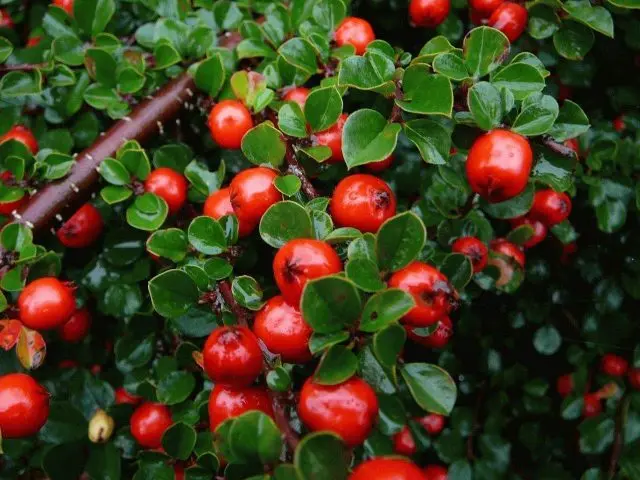
Cotoneaster (pictured) is a low sprawling or creeping non-thorny shrub. Under favorable conditions, its lifespan can reach 50 years. It grows quite slowly, adding only a few centimeters per year. The leaves are small, green, usually shiny, turning red in autumn (in deciduous species). The flowers are small, solitary or collected in racemes, white or pink. Its fruits are small apples, most often inedible, red, rarely black.
More than 200 species of cotoneaster are described in the scientific literature. Here are just a few of them:
- Common cotoneaster.
- Cotoneaster shining.
- Cotoneaster chokeberry.
- Cotoneaster Dummer and others.
The use of cotoneaster in landscape design
The cotoneaster shrub is very unpretentious. It easily tolerates gas pollution, grows well on any soil, and is resistant to frost and drought. Most often it is used to decorate hedges, alleys, parks, alpine slides. The root system of this plant is very close to the surface, so often creeping species of this shrub are planted on artificial embankments, solving the problem of strengthening the soil, and at the same time for decorating slopes.
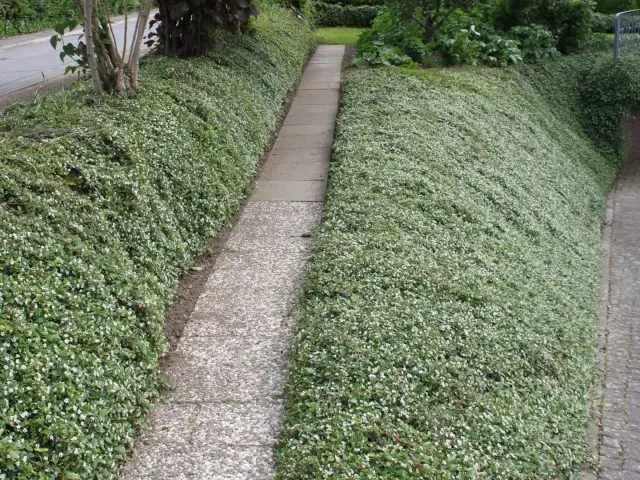
In total, more than 80 species of this beautiful plant are used in landscape design. Among them there are erect, bushy, and creeping species. Therefore, the scope of cotoneaster for decorative purposes is very wide.
Are cotoneaster berries edible or not?
Most types of cotoneaster have inedible fruits. You can only eat cotoneaster chokeberry. They do not differ in any special taste and are more often used to prepare decoctions for the treatment of the stomach. Dried chokeberry fruits are often added to tea, as they contain quite a lot of vitamins. They can be used as a coloring agent in the production of homemade tinctures or liqueurs.
Planting and caring for cotoneaster in the open field
Growing this ornamental shrub usually does not cause any trouble. It is planted with one-year or two-year-old seedlings. The best time for this is spring, the period before the start of the growing season or autumn, after the end of leaf fall.
Site selection and soil preparation
This ornamental shrub does not impose special requirements on the place of growth and the nature of the soil. It is desirable that the place be sunny, then all its decorative properties will manifest themselves in full. Bushes are planted in single pits about half a meter deep. If a cotoneaster hedge is created, planting is carried out in a ditch of the same depth. A drainage layer of broken brick or crushed stone is laid on the bottom, on top of which a layer of nutrient soil is poured from a mixture of soddy soil, humus and peat in a ratio of 2: 1: 1.
Planting cotoneaster
Seedlings are placed vertically and covered with a layer of soil, periodically compacting it. The plant is deepened to the level of the root neck, which should be at ground level. After planting, the root zone should be watered abundantly.
A video of planting a cotoneaster can be viewed at the link below.
What can be planted next to the cotoneaster
This plant is not an antagonist and gets along well with all neighbors. It looks good next to low coniferous trees; flower beds can be placed next to it. Shrubs can be planted as a group or singly, shaping them with shearing and using them as architectural accents. In the photo below – a cotoneaster hedge.
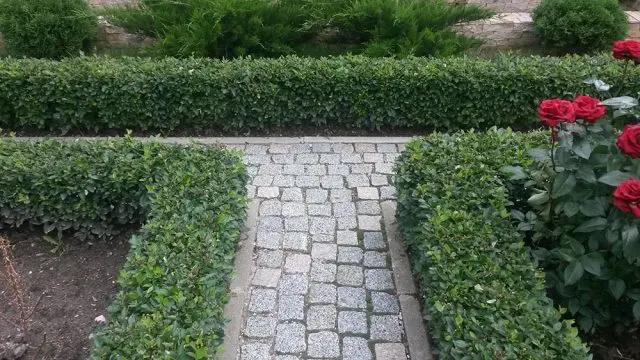
Slate types are often used as an artificial turf, hiding under it the unevenness of the terrain.
Growing and caring for cotoneaster
Caring for a planted cotoneaster will not cause difficulties. Often, the only activity that is carried out with a shrub is its haircut or pruning to maintain a decorative shape.
How to water cotoneaster
Precipitation is usually sufficient for normal development and growth of plants. The bushes are usually watered with a hose or sprinkler to wash off the dust from the leaves. This is especially true for bushes located along busy streets. If the summer is very dry, once a month you can make abundant watering.
Top dressing cotoneaster
Most gardeners consider fertilizing cotoneaster optional. However, when growing on poor soils, it is worth feeding shrubs at least once a season. This is best done in the spring by adding a solution of urea (25 g per 10 l of water) to the root zone, and later, before flowering, superphosphate and any potassium fertilizer (60 and 15 g per 1 sq. meter, respectively). In autumn, the root zone is mulched with peat, which also serves as a kind of top dressing.
pruning cotoneaster
For sanitary and rejuvenating purposes, the cotoneaster is pruned in the spring, before the start of the growing season. The shrub tolerates this procedure well and problems after its implementation, as a rule, do not arise.

It is possible to cut the shrub for decorative purposes, cutting the crown in the form of various figures, at any time of the year, except for winter.
Preparing cotoneaster for winter
Cotoneaster is a frost-resistant plant and tolerates cold well. Special preparation for winter is not necessary, usually it is enough to simply mulch the root zone with a layer of peat 8–10 cm thick. In regions with significant frosts and lack of snow cover, it is recommended to bend the bushes to the ground and fix in this position, and then throw them with fallen leaves.
Diseases and pests of cotoneaster
Cotoneaster bushes are quite rarely affected by both pests and various diseases. Fusarium, a fungus that develops in conditions of high humidity, can pose the greatest danger to plantings. They fight it by removing the affected parts of the plant, as well as spraying the shrub with systemic fungicides.
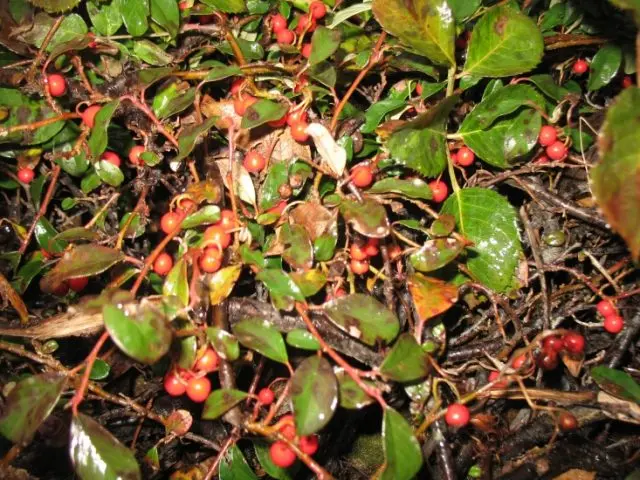
Among the pests on the cotoneaster most often appear:
- Aphid.
- Spider mite.
- Shchitovka.
They fight pests by spraying bushes with special preparations:
- Fitoverm.
- Karbofos.
- You decide.
- Action.
Pest control can be done several times per season. The first time spraying is done after the buds swell, the second time after flowering and the third time after another two weeks. This measure is the exception rather than the rule. Pests appear on this plant quite infrequently, and in most cases one treatment is enough.
How to propagate cotoneaster
Cotoneaster reproduces well by all methods characteristic of shrubs. It can be propagated:
- seeds;
- cuttings;
- layering;
- division of the bush.
For varietal types of cotoneaster, grafting can be used.
Cuttings
Propagation by cuttings is a simple and reliable way to get cotoneaster seedlings. This procedure is best done in late June – early July. For harvesting green cuttings, the central part of the annual shoot is used. The cut cuttings are freed from leaves by about 1/3, then they are kept in a solution of a root formation stimulator for 6 hours.

After that, they are planted at an angle in containers filled with a nutrient substrate – a mixture of peat and river sand. The container with the cuttings is watered and covered with a film, providing greenhouse conditions for the cuttings. Regularly such a mini-greenhouse needs to be ventilated. As a rule, the percentage of rooting of green cuttings planted in this way is very high. After a year, when the root system has developed sufficiently, the seedlings can be planted in a permanent place.
Layers
Layers from the mother bush, especially on creeping shrubs, can be formed without human intervention. Often, branches that come into contact with the soil take root on their own.
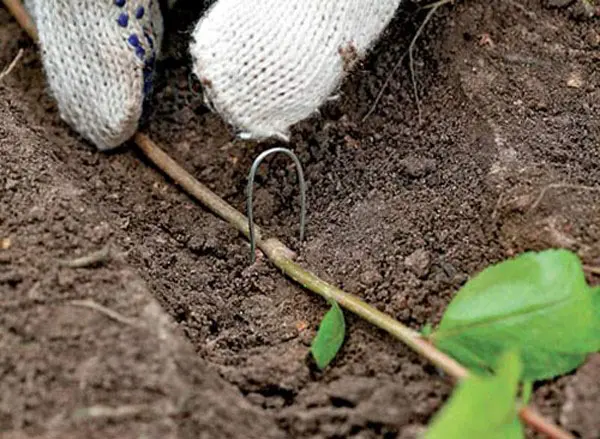
Getting full-fledged layering artificially is quite simple. To do this, the extreme shoots are simply fixed on the ground with an iron bracket and covered with humus from above. The soil in this place must be regularly moistened. After a few weeks, the pressed stem will give roots and begin to form independent shoots. Then the layers are separated from the mother bush and transferred to the place of permanent landing.
Seeds
Propagation by seeds is a rather long method, and it is usually used only by breeders who are busy breeding new varieties. Getting a seedling from a seed is quite difficult. The seeds of this plant do not have good germination, and the seedlings are weak and often die. Before the formation of full-fledged seedlings and transplanting them to a permanent place, it usually takes about 3-4 years.

Seeds are removed from the fruit, washed and sorted. At the initial stage, you can cull them by immersing them in water. Those that remain on the surface are empty, they are immediately discarded. Then the seeds are subjected to stratification. To do this, they are kept at a temperature of + 30 ° C for two months, and then slowly lower it to -5 ° C. Prepared seeds are sown in autumn in nutrient soil, watered and placed under a film.
By dividing the bush
The method of dividing the bush is simple and effective. It is used during the transplantation of adult bushes or if the shrub has grown strongly. In this case, part of the root, along with the shoots, is cut off from the main rhizome and transplanted to another place. This procedure can be carried out both in spring, before the start of the growing season, and in autumn, after the leaves fall.
cotoneaster transplant
This is one of the few shrubs that transfers transplantation from place to place without any problems at any time of the year. It is best to transplant cotoneaster in autumn or spring while the plant is dormant. Its roots are located quite close to the surface, so extracting a bush from the ground is usually not difficult. It is better to transfer it to another place along with a clod of earth on the roots, this will significantly reduce the time it takes for the bush to adapt to a new place.
Conclusion
Cotoneaster rightfully takes its place among the most common shrubs used in landscape design. The number and variety of its species allows it to be used in a variety of places, from garden and park areas to the design of alpine slides. And undemanding care makes it a truly versatile plant, which even the most inexperienced gardener can grow.









